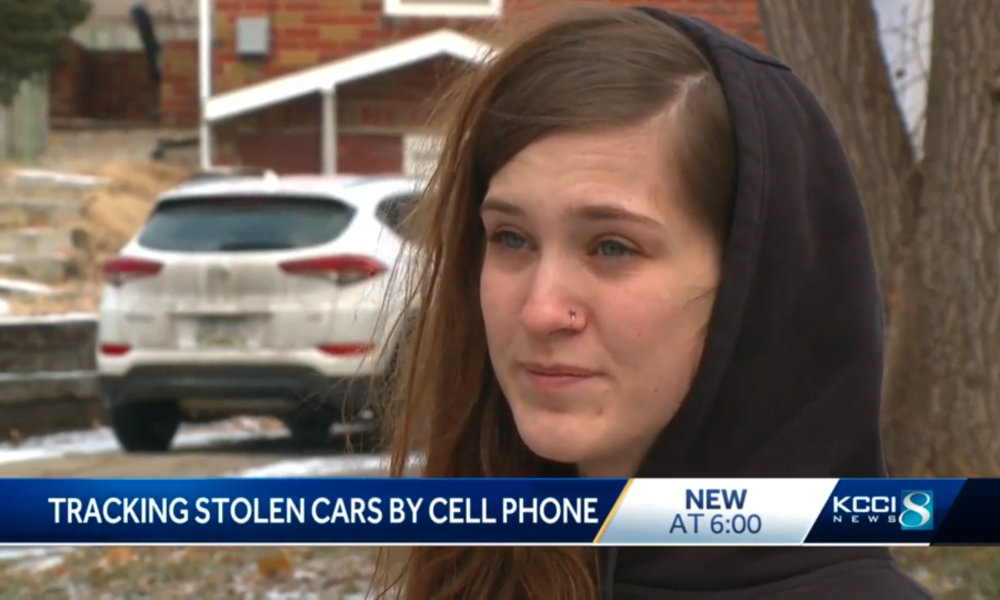How Apple’s ‘Find My’ Feature Helped This Woman Find Her Stolen Car
 Credit: KCCI Des Moines
Credit: KCCI Des Moines
Toggle Dark Mode
Originally known as Find My iPhone, Apple’s Find My feature has been around for years, and it turns out it can be useful for locating a lot more than just a missing iPhone, since of course it can help track down whatever the iPhone is currently attached to as well, as one woman in Iowa recently discovered.
According to KCCI Des Moines, 19-year-old Victoria O’Connor found Apple’s feature particularly helpful when her car was stolen with her iPhone and wallet inside. O’Connor reported it to police who worked to track it down with the Find My app, but lost the signal when the iPhone was powered off — either because the thieves had been clever enough do so or the battery had simply gone dead.
O’Connor’s car was stolen Monday night at a local convenience store, where she had left the car running while she made a quick stop, and had been the young woman’s de facto home since a fire had destroyed her apartment building in September, so needless to say she was eager to find the car since it contained all of the personal belongings she had left.
Fortunately, on Tuesday morning o’Connor was alerted that the missing iPhone had come back online, and police were able to use Find My to locate the stolen car at a nearby apartment building.
Sadly, while the car was recovered, the iPhone itself was no longer in it, neither were O’Connor’s keys or wallet. Police believe the iPhone is inside one of the apartment units, but are still working to track down which one.
The technology is great. It does help us solve a lot of these crimes.
Des Moines police Sgt. Paul Parizek
Des Moines police said they while they frequently get calls to track down stolen iPhones, it’s much more unusual to use a stolen iPhone to find a stolen car.
Police are also reviewing camera footage from the QuikTrip where the car was stolen in hopes of identifying the thieves. It’s not yet clear why the iPhone came back online, although presumably one of the culprits switched it back on, or simply plugged it in to recharge after the battery went dead.
While it’s unclear what steps the police have taken to track down the iPhone, I once had success locating a lost iPhone in an apartment building using the Play Sound feature of Find My to keep make it repeatedly sound alerts until I was able to locate the apartment that the sound was coming from, although in this case it helped that I already knew the specific floor on which the iPhone had been lost.
Find My in iOS 13
While we haven’t heard much about it since the release of iOS 13, Apple has worked out a clever way of locating devices using Find My even when they’re switched off. In fact, it’s entirely possible that this was the method that O’Connor and the police were able to use without even realizing it, since the report doesn’t indicate that the iPhone was switched back on, but merely that it started “pinging” again.
With iOS 13, an iPhone, iPad, iPod touch, or even a MacBook or Apple Watch can be located when it’s offline — either powered off or simply disconnected from a network — by any other nearby device running the latest version of iOS, macOS, or watchOS. This is done by using crowdsourced data from other nearby Apple devices that can locate the Bluetooth signal from the missing device.
How to Make Sure ‘Offline Finding’ Is Enabled
For privacy reasons, Apple allows users to turn off this ability to find an iPhone or other device when it’s offline or powered off, and while it should be switched on by default, you can check this for yourself with a quick trip into your iOS Settings app:
- Open Settings on your iPhone or iPad
- Tap your name at the top of the Settings app
- Tap Find My
- Tap Find My iPhone (or iPad, or iPod touch)
- Ensure Enable Offline Finding is switched on
Since Offline Finding only works if another Apple device is nearby, we recommend enabling the Send Last Location setting here as well, which will automatically report the location of your iPhone when the battery is critically low, improving the chances that you’ll be able to find it if it runs out of power.






